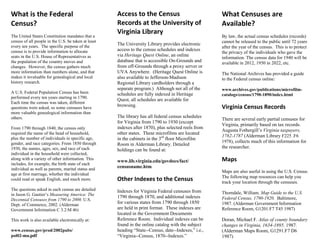Using the US Federal Census in Genealogy Handout
- 1. Census┬ĀTips┬Ā 1790: No Federal census schedules are known to exist for Delaware, Georgia, Kentucky, New Jersey, Tennessee, and Virginia; apparently they were destroyed during the British attack on Washington during the War of 1812. The 1790 schedules for Virginia that appear on the National Archives and Records Administration microfilms were reconstructed from state enumerations. Some counties in Pennsylvania are also missing. 1790 through 1860: Kentucky became a state in 1792, so its 1790 census information is included in VirginiaŌĆÖs census. West Virginia did not separate from Virginia until after the 1860 census. You will find records for West Virginia locations in the Virginia census through 1860. 1800: Virginia census schedules for 1800 cannot be located, and are presumed destroyed. 1850 & 1860: Separate censuses of the slave population were taken in these years, although the names of enslaved individuals were not generally recorded. 1890: Most of the 1890 population schedules were badly damaged by a fire in the Commerce Department Building in January 1921. Only a very few records survive. For more information, contact the Alderman Library Information Desk, 434-924-3516 or 434-924-3021. Version 2007b- 10/9/2008 (jlc) Census┬ĀBibliography┬Ā Dollarhide, William. The census book: a genealogist's guide to federal census facts, schedules and indexes: with master extraction forms for federal census schedules, 17901930. Bountiful, Utah : Heritage Quest, c2000. (Alderman Library HA214 .D65 2000) Federal Population and Mortality Census Schedules, 1790-1910, in the National Archives and the States: Outline of a Lecture on Their Availability, Content and Use. Special List 24. National Archives and Records Service, rev. 1986. (Alderman Government Information Reading Room Reference AE 1.115:24) Greene, Evarts B. & Virginia D. Harrington. American Population Before the Federal Census of 1790. Baltimore: Genealogical Publishing Co., Inc., reprint 1993. (Alderman Library Reference Room HB3505 .G7 1932) Greenwood, Val D. The Researcher's Guide to American Genealogy. 2d ed. Baltimore: Genealogical Publishing Company, Inc., 1990. (Alderman Library Reference Room CS47 .G73 1990) Hinckley, Kathleen W. Your Guide to The Federal Census: For Genealogists, Researchers and Family Historians. Betterway Books, 2002. (Alderman Library HA37 .U6 H556 2002) Lainhart, Ann S. State Census Records. Baltimore: Genealogical Publishing Company, Inc., 1992. (Alderman Library Reference Room HA215 .L25 1992) U.S. CENSUS RESOURCES A GUIDE FOR GENEALOGISTS AND LOCAL HISTORIANS
- 2. What┬Āis┬Āthe┬ĀFederal┬Ā Census?┬Ā The United States Constitution mandates that a census of all people in the U.S. be taken at least every ten years. The specific purpose of the census is to provide information to allocate seats in the U.S. House of Representatives as the population of the country moves and changes. However, the census gathers much more information than numbers alone, and that makes it invaluable for genealogical and local history research. A U.S. Federal Population Census has been performed every ten years starting in 1790. Each time the census was taken, different questions were asked, so some censuses have more valuable genealogical information than others. From 1790 through 1840, the census only required the name of the head of household, plus the number of individuals in specific age, gender, and race categories. From 1850 through 1930, the names, ages, sex, and race of each individual in the household were collected, along with a variety of other information. This includes, for example, the birth state of each individual as well as parents, marital status and age at first marriage, whether the individual could read or speak English, and much more. The questions asked in each census are detailed in Jason G. GautierŌĆÖs Measuring America: The Decennial Censuses from 1790 to 2000. U.S. Dept. of Commerce, 2002. (Alderman Government Information C 3.2:M 46) This work is also available electronically at: www.census.gov/prod/2002pubs/ pol02-ma.pdf Access┬Āto┬Āthe┬ĀCensus┬Ā Records┬Āat┬Āthe┬ĀUniversity┬Āof┬Ā Virginia┬ĀLibrary┬Ā The University Library provides electronic access to the census schedules and indexes via Heritage Quest Online, an online database that is accessible On-Grounds and from off-Grounds through a proxy server or UVA Anywhere. (Heritage Quest Online is also available to Jefferson-Madison Regional Library cardholders through a separate program.) Although not all of the schedules are fully indexed in Heritage Quest, all schedules are available for browsing. The library has all federal census schedules for Virginia from 1790 to 1930 (except indexes after 1870), plus selected reels from other states. These microfilms are located in the cabinets in the 3rd floor Microfilm Room in Alderman Library. Detailed holdings can be found at: www.lib.virginia.edu/govdocs/fact/ censusname.htm Other┬ĀIndexes┬Āto┬Āthe┬ĀCensus┬Ā Indexes for Virginia Federal censuses from 1790 through 1870, and additional indexes for various states from 1790 through 1850 are held in print format. These indexes are located in the Government Documents Reference Room. Individual indexes can be found in the online catalog with the subject heading ŌĆ£State--Census, date--Indexes,ŌĆØ i.e., ŌĆ£Virginia--Census, 1870--Indexes.ŌĆØ What┬ĀCensuses┬Āare┬Ā Available?┬Ā By law, the actual census schedules (records) cannot be released to the public until 72 years after the year of the census. This is to protect the privacy of the individuals who gave the information. The census data for 1940 will be available in 2012, 1950 in 2022, etc. The National Archives has provided a guide to the Federal census online: www.archives.gov/publications/microfilmcatalogs/census/1790-1890/index.html Virginia┬ĀCensus┬ĀRecords┬Ā There are several early partial censuses for Virginia, primarily based on tax records. Augusta FothergillŌĆÖs Virginia taxpayers, 1782-1787 (Alderman Library F225 .F6 1978), collects much of this information for the researcher. Maps┬Ā Maps are also useful in using the U.S. Census. The following map resources can help you track your location through the censuses. Thorndale, William. Map Guide to the U.S. Federal Census, 1790-1920. Baltimore, 1987. (Alderman Government Information Reference Room, G1201.F7 T45 1987) Doran, Michael F. Atlas of county boundary changes in Virginia, 1634-1895. 1987. (Alderman Maps Room, G1291.F7 D6 1987)

